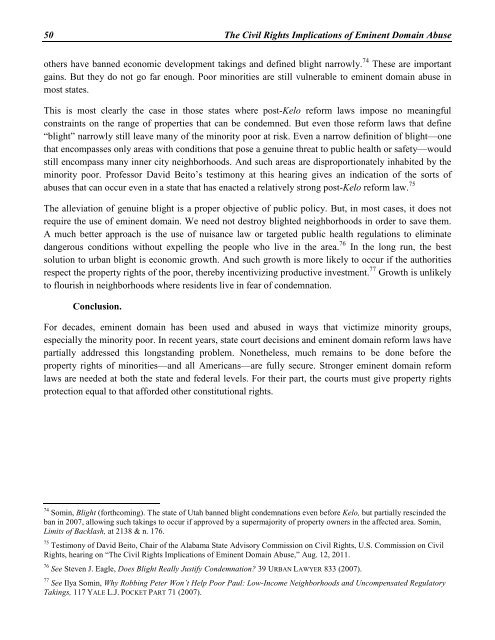Panelists’ Written Statements 49But it is generally effective for privately owned development projects of the sort at issue in Kelo andmost other blight and economic development takings.III.Why Post-Kelo <strong>Eminent</strong> <strong>Domain</strong> Reform is Not Enough.The Supreme Court’s controversial decision in Kelo v. City of New London generated a massive politicalbacklash that some believe has greatly diminished the problem of eminent domain abuse. Kelo was oneof the most unpopular Supreme Court decisions in history, with polls showing that over 80 percent ofthe public opposing the ruling. 66 As a result, forty-three states 67 and the federal government enactedlegislation intended to curb economic development takings in the years since Kelo. 68Unfortunately, the majority of the new reform laws are likely to be ineffective, imposing few or nomeaningful constraints on the use of eminent domain. 69 Many of them forbid takings that transferproperty to private parties for “economic development,” but allow virtually identical condemnations tocontinue under other names. For example, numerous states continue to allow “blight” condemnationsunder definitions of blight so broad that virtually any area qualifies. 70Many of the states that have enacted ineffective post-Kelo reforms or no reforms at all are among thosethat make the most extensive use of eminent domain for the benefit of private interests. 71 They includesuch large states as California, New York, New Jersey, and Texas. 72 The ineffectiveness of many post-Kelo reforms is in part caused by public ignorance. Survey data shows that only about 13 percent ofAmericans know whether their state has enacted a post-Kelo eminent domain reform law and whetherthat law is likely to be effective or not. 73 Public ignorance enables state legislators to satisfy publicdemand for action on eminent domain without adopting laws that genuinely constrain blight andeconomic development takings.Some real progress has been made as a result of the Kelo backlash. Four states—most notably Florida —now forbid both “blight” and economic development condemnations completely, and about fifteen66 Ilya Somin, The Limits of Backlash: Assessing the Political Response to Kelo, 93 MINN. L. REV. 2100, 2108-14 (2009).67 [The number of states enacting reform legislation on economic development takings increased to 44 after the Commissionheld its briefing, as indicated earlier in this report. -Ed.]68 Id. at 2101-02. For the most comprehensive analysis of post-Kelo reform legislation, see id. at 2114-53. See also Edward J.López et al., Pass a Law, Any Law, State Legislative Responses to the Kelo Backlash, 5 REV. LAW & ECON. 101, (2009),available at http://www.bepress.com/rle/vol5/iss1/art5/; Andrew Morriss, Symbol or Substance? An Empirical Assessment ofState Responses to Kelo, 17 SUP. CT. ECON. REV. 237, (2009); James W. Ely, Jr., Post-Kelo Reform: Is the Glass Half-Full orHalf-Empty?, 17 SUP. CT. ECON. REV. 127 (2009); Timothy Sandefur, The “Backlash” So Far: Will Americans GetMeaningful <strong>Eminent</strong> <strong>Domain</strong> Reform?, 2006 MICH. ST. L. REV. 709 (2006); Lynn Blais, Urban Revitalization in the Post-Kelo Era, 34 FORDHAM URBAN L.J. 657 (2007).69 Somin, Limits of Backlash, at 2120-35.70 Id. at 2120-28. See also the discussion of blight condemnations in § II.B., infra.71 Id. at 2117-20.72 Id.73 Id. at 2154-70.
50 The Civil Rights Implications of <strong>Eminent</strong> <strong>Domain</strong> Abuseothers have banned economic development takings and defined blight narrowly. 74 These are importantgains. But they do not go far enough. Poor minorities are still vulnerable to eminent domain abuse inmost states.This is most clearly the case in those states where post-Kelo reform laws impose no meaningfulconstraints on the range of properties that can be condemned. But even those reform laws that define“blight” narrowly still leave many of the minority poor at risk. Even a narrow definition of blight—onethat encompasses only areas with conditions that pose a genuine threat to public health or safety—wouldstill encompass many inner city neighborhoods. And such areas are disproportionately inhabited by theminority poor. Professor David Beito’s testimony at this hearing gives an indication of the sorts ofabuses that can occur even in a state that has enacted a relatively strong post-Kelo reform law. 75The alleviation of genuine blight is a proper objective of public policy. But, in most cases, it does notrequire the use of eminent domain. We need not destroy blighted neighborhoods in order to save them.A much better approach is the use of nuisance law or targeted public health regulations to eliminatedangerous conditions without expelling the people who live in the area. 76 In the long run, the bestsolution to urban blight is economic growth. And such growth is more likely to occur if the authoritiesrespect the property rights of the poor, thereby incentivizing productive investment. 77 Growth is unlikelyto flourish in neighborhoods where residents live in fear of condemnation.Conclusion.For decades, eminent domain has been used and abused in ways that victimize minority groups,especially the minority poor. In recent years, state court decisions and eminent domain reform laws havepartially addressed this longstanding problem. Nonetheless, much remains to be done before theproperty rights of minorities—and all Americans—are fully secure. Stronger eminent domain reformlaws are needed at both the state and federal levels. For their part, the courts must give property rightsprotection equal to that afforded other constitutional rights.74 Somin, Blight (forthcoming). The state of Utah banned blight condemnations even before Kelo, but partially rescinded theban in 2007, allowing such takings to occur if approved by a supermajority of property owners in the affected area. Somin,Limits of Backlash, at 2138 & n. 176.75 Testimony of David Beito, Chair of the Alabama State Advisory Commission on Civil Rights, U.S. Commission on CivilRights, hearing on “The Civil Rights Implications of <strong>Eminent</strong> <strong>Domain</strong> Abuse,” Aug. 12, 2011.76 See Steven J. Eagle, Does Blight Really Justify Condemnation? 39 URBAN LAWYER 833 (2007).77 See Ilya Somin, Why Robbing Peter Won’t Help Poor Paul: Low-Income Neighborhoods and Uncompensated RegulatoryTakings, 117 YALE L.J. POCKET PART 71 (2007).


